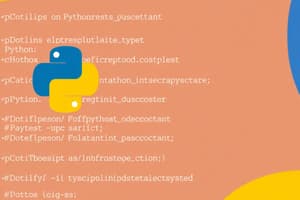Podcast
Questions and Answers
What is the purpose of using indentation in Python code?
What is the purpose of using indentation in Python code?
To define code blocks (like loops, functions, classes, conditional statements). Python uses indentation rather than braces or keywords.
Which of the following is a mutable data type in Python?
Which of the following is a mutable data type in Python?
- List (correct)
- String
- Integer
- Tuple
Which method would you use to convert a string to uppercase in Python?
Which method would you use to convert a string to uppercase in Python?
The .upper() method.
Which of the following statements about Python lists is true?
Which of the following statements about Python lists is true?
Which of the following is a valid way to define a dictionary in Python?
Which of the following is a valid way to define a dictionary in Python?
Which of the following data types is immutable in Python?
Which of the following data types is immutable in Python?
What will happen if you try to add a duplicate element to a set?
What will happen if you try to add a duplicate element to a set?
What is the correct way to open a file for writing in Python?
What is the correct way to open a file for writing in Python?
Which statement correctly describes how to import a specific function from a module?
Which statement correctly describes how to import a specific function from a module?
What is the output of the following code? print([x * 2 for x in range(5)])
What is the output of the following code? print([x * 2 for x in range(5)])
Flashcards
Purpose of indentation in Python
Purpose of indentation in Python
Indentation is used to define blocks of code, indicating which statements belong to a particular control structure (e.g., loops, conditional statements, functions).
Mutable data type in Python
Mutable data type in Python
A mutable data type is one that can be changed after it is created. Lists and dictionaries are mutable, tuples are not.
Convert a string to uppercase
Convert a string to uppercase
The .upper() method converts all characters in a string to uppercase.
Python lists
Python lists
Signup and view all the flashcards
Define a dictionary in Python
Define a dictionary in Python
Signup and view all the flashcards
Immutable data type in Python
Immutable data type in Python
Signup and view all the flashcards
Add a duplicate to a set
Add a duplicate to a set
Signup and view all the flashcards
Open a file for writing
Open a file for writing
Signup and view all the flashcards
Import a specific function
Import a specific function
Signup and view all the flashcards
Output of list comprehension
Output of list comprehension
Signup and view all the flashcards
Study Notes
- Indentation in Python code is used to define the structure and scope of code blocks.
- A mutable data type in Python that can be changed after creation is a list.
- In Python, the
upper()method can be used to convert a string to uppercase. - Lists are mutable, ordered sequences of items and can contain a mix of data types.
- A valid way to define a dictionary in Python is using curly braces
{}with key-value pairs separated by colons. - Strings and tuples are examples of immutable data types in Python, meaning their values cannot be changed after they are created.
- If you try to add a duplicate element to a set, it will not be added, as sets only store unique elements.
- The correct way to open a file for writing in Python is by using the
open()function with the mode'w'. - To import a specific function from a module, you can use the
from module import functionstatement. - The output of the code
print([x * 2 for x in range(5)])will be[0, 2, 4, 6, 8], because the list comprehension iterates through the numbers 0 to 4 and doubles each value.
Studying That Suits You
Use AI to generate personalized quizzes and flashcards to suit your learning preferences.




